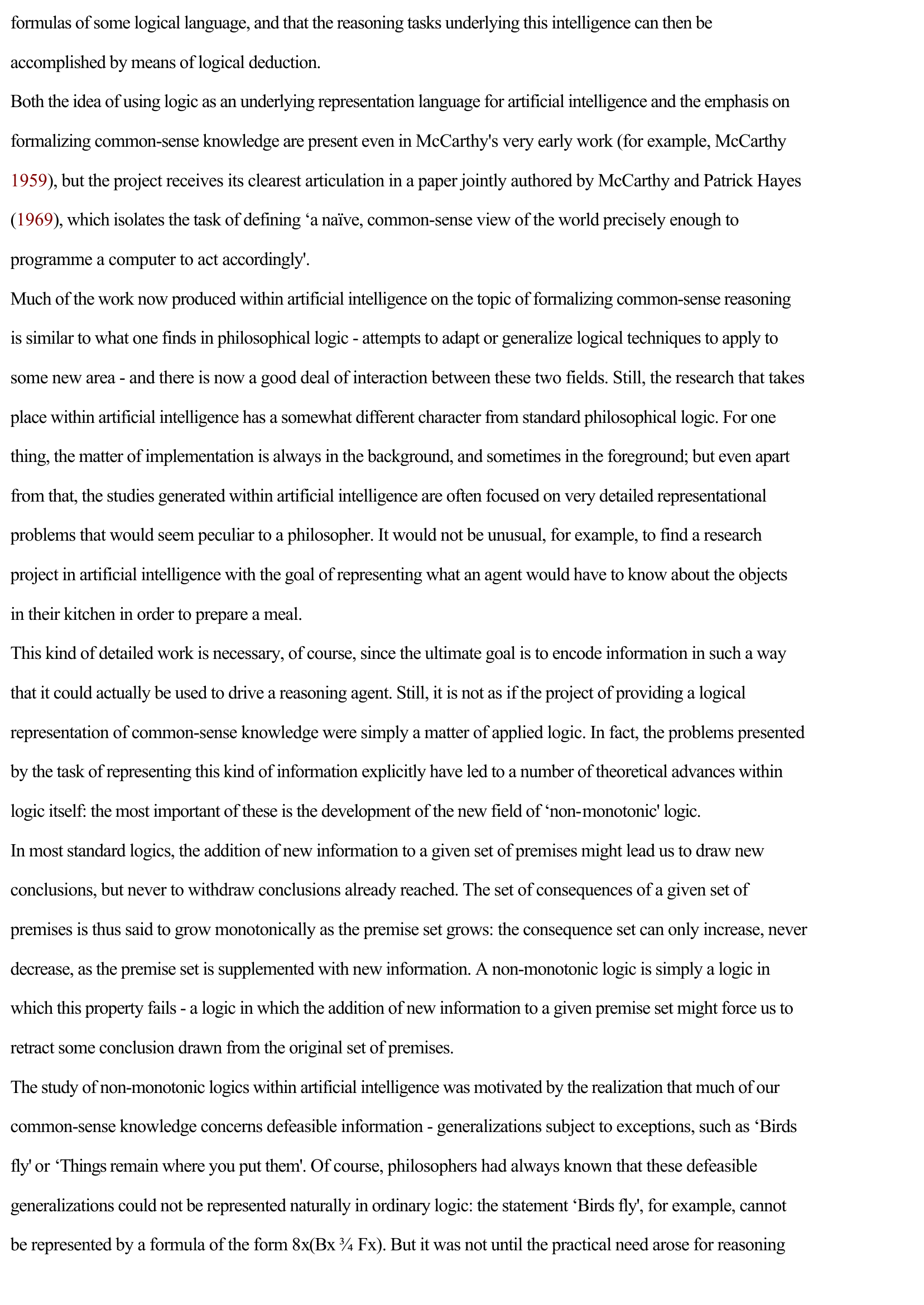theories of Common-sense reasoning
Publié le 22/02/2012

Extrait du document
«
formulas of some logical language, and that the reasoning tasks underlying this intelligence can then be
accomplished by means of logical deduction.
Both the idea of using logic as an underlying representation language for artificial intelligence and the emphasis on
formalizing common-sense knowledge are present even in McCarthy's very early work (for example, McCarthy
1959 ), but the project receives its clearest articulation in a paper jointly authored by McCarthy and Patrick Hayes
(1969 ), which isolates the task of defining ‘a naïve , common-sense view of the world precisely enough to
programme a computer to act accordingly' .
Much of the work now produced within artificial intelligence on the topic of formalizing common-sense reasoning
is similar to what one finds in philosophical logic - attempts to adapt or generalize logical techniques to apply to
some new area - and there is now a good deal of interaction between these two fields.
Still, the research that takes
place within artificial intelligence has a somewhat different character from standard philosophical logic.
For one
thing, the matter of implementation is always in the background, and sometimes in the foreground; but even apart
from that, the studies generated within artificial intelligence are often focused on very detailed representational
problems that would seem peculiar to a philosopher.
It would not be unusual, for example, to find a research
project in artificial intelligence with the goal of representing what an agent would have to know about the objects
in their kitchen in order to prepare a meal.
This kind of detailed work is necessary, of course, since the ultimate goal is to encode information in such a way
that it could actually be used to drive a reasoning agent.
Still, it is not as if the project of providing a logical
representation of common-sense knowledge were simply a matter of applied logic.
In fact, the problems presented
by the task of representing this kind of information explicitly have led to a number of theoretical advances within
logic itself: the most important of these is the development of the new field of ‘non -monotonic' logic.
In most standard logics, the addition of new information to a given set of premises might lead us to draw new
conclusions, but never to withdraw conclusions already reached.
The set of consequences of a given set of
premises is thus said to grow monotonically as the premise set grows: the consequence set can only increase, never
decrease, as the premise set is supplemented with new information.
A non-monotonic logic is simply a logic in
which this property fails - a logic in which the addition of new information to a given premise set might force us to
retract some conclusion drawn from the original set of premises.
The study of non-monotonic logics within artificial intelligence was motivated by the realization that much of our
common-sense knowledge concerns defeasible information - generalizations subject to exceptions, such as ‘Birds
fly' or ‘Things remain where you put them' .
Of course, philosophers had always known that these defeasible
generalizations could not be represented naturally in ordinary logic: the statement ‘Birds fly' , for example, cannot
be represented by a formula of the form 8x(Bx ¾ Fx).
But it was not until the practical need arose for reasoning.
»
↓↓↓ APERÇU DU DOCUMENT ↓↓↓
Liens utiles
- REID AND COMMON SENSE - HUME
- Common-sense ethics
- common law v equity
- Du symbolisme au surréalisme par Claude-Edmonde Magny Poetry is a divine instinct and unnatural rage passing the reach of common reason.
- Cours Theories Economique Comparées







